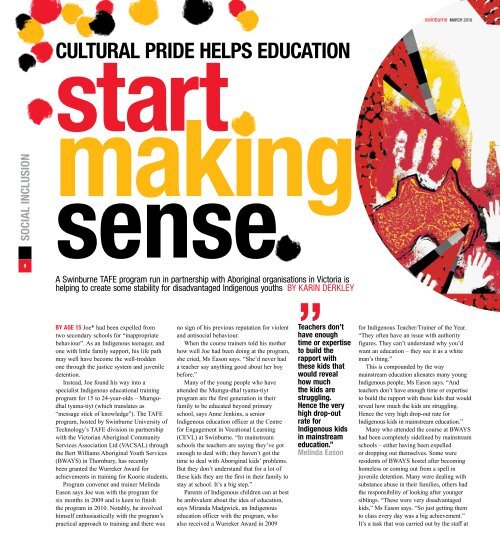March 2010 - Swinburne University of Technology
March 2010 - Swinburne University of Technology
March 2010 - Swinburne University of Technology
You also want an ePaper? Increase the reach of your titles
YUMPU automatically turns print PDFs into web optimized ePapers that Google loves.
swinburne <strong>March</strong> <strong>2010</strong><br />
social inclusion<br />
8<br />
Cultural pride helps education<br />
start<br />
making<br />
sense<br />
A <strong>Swinburne</strong> TAFE program run in partnership with Aboriginal organisations in Victoria is<br />
helping to create some stability for disadvantaged Indigenous youths By Karin Derkley<br />
By age 15 Joe* had been expelled from<br />
two secondary schools for “inappropriate<br />
behaviour”. As an Indigenous teenager, and<br />
one with little family support, his life path<br />
may well have become the well-trodden<br />
one through the justice system and juvenile<br />
detention.<br />
Instead, Joe found his way into a<br />
specialist Indigenous educational training<br />
program for 15 to 24-year-olds – Mumgudhal<br />
tyama-tiyt (which translates as<br />
“message stick <strong>of</strong> knowledge”). The TAFE<br />
program, hosted by <strong>Swinburne</strong> <strong>University</strong> <strong>of</strong><br />
<strong>Technology</strong>’s TAFE division in partnership<br />
with the Victorian Aboriginal Community<br />
Services Association Ltd (VACSAL) through<br />
the Bert Williams Aboriginal Youth Services<br />
(BWAYS) in Thornbury, has recently<br />
been granted the Wurreker Award for<br />
achievements in training for Koorie students.<br />
Program convener and trainer Melinda<br />
Eason says Joe was with the program for<br />
six months in 2009 and is keen to finish<br />
the program in <strong>2010</strong>. Notably, he involved<br />
himself enthusiastically with the program’s<br />
practical approach to training and there was<br />
no sign <strong>of</strong> his previous reputation for violent<br />
and antisocial behaviour.<br />
When the course trainers told his mother<br />
how well Joe had been doing at the program,<br />
she cried, Ms Eason says. “She’d never had<br />
a teacher say anything good about her boy<br />
before.”<br />
Many <strong>of</strong> the young people who have<br />
attended the Mumgu-dhal tyama-tiyt<br />
program are the first generation in their<br />
family to be educated beyond primary<br />
school, says Anne Jenkins, a senior<br />
Indigenous education <strong>of</strong>ficer at the Centre<br />
for Engagement in Vocational Learning<br />
(CEVL) at <strong>Swinburne</strong>. “In mainstream<br />
schools the teachers are saying they’ve got<br />
enough to deal with; they haven’t got the<br />
time to deal with Aboriginal kids’ problems.<br />
But they don’t understand that for a lot <strong>of</strong><br />
these kids they are the first in their family to<br />
stay at school. It’s a big step.”<br />
Parents <strong>of</strong> Indigenous children can at best<br />
be ambivalent about the idea <strong>of</strong> education,<br />
says Miranda Madgwick, an Indigenous<br />
education <strong>of</strong>ficer with the program, who<br />
also received a Wurreker Award in 2009<br />
,,<br />
Teachers don’t<br />
have enough<br />
time or expertise<br />
to build the<br />
rapport with<br />
these kids that<br />
would reveal<br />
how much<br />
the kids are<br />
struggling.<br />
Hence the very<br />
high drop‐out<br />
rate for<br />
Indigenous kids<br />
in mainstream<br />
education.”<br />
Melinda Eason<br />
for Indigenous Teacher/Trainer <strong>of</strong> the Year.<br />
“They <strong>of</strong>ten have an issue with authority<br />
figures. They can’t understand why you’d<br />
want an education – they see it as a white<br />
man’s thing.”<br />
This is compounded by the way<br />
mainstream education alienates many young<br />
Indigenous people, Ms Eason says. “And<br />
teachers don’t have enough time or expertise<br />
to build the rapport with these kids that would<br />
reveal how much the kids are struggling.<br />
Hence the very high drop-out rate for<br />
Indigenous kids in mainstream education.”<br />
Many who attended the course at BWAYS<br />
had been completely sidelined by mainstream<br />
schools – either having been expelled<br />
or dropping out themselves. Some were<br />
residents <strong>of</strong> BWAYS hostel after becoming<br />
homeless or coming out from a spell in<br />
juvenile detention. Many were dealing with<br />
substance abuse in their families, others had<br />
the responsibility <strong>of</strong> looking after younger<br />
siblings. “These were very disadvantaged<br />
kids,” Ms Eason says. “So just getting them<br />
to class every day was a big achievement.”<br />
It’s a task that was carried out by the staff at
















